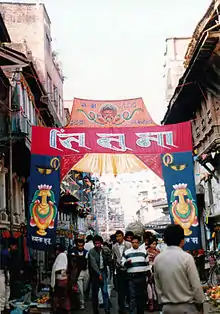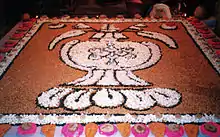Kachhala (month)
Kachhalā (Nepal Bhasa: कछला) is the first month in the Nepal Era calendar, the national lunar calendar of Nepal.[1] The month corresponds to Kārtik in the Hindu lunar calendar and roughly matches November in the Gregorian calendar.


Kachhalā begins with the new moon and the full moon falls on the 15th of the lunar month. The month is divided into the bright and dark fortnights which are known as Kachhalā Thwa (कछला थ्व) and Kachhalā Gā (कछला गा) respectively.
The most important festival that occurs during this month is Tihar (Swanti). The first day of the bright fortnight of Kachhalā is New Year's Day when Newars observe Mha Puja, an auspicious ceremony to invoke good fortune during the coming year.[2]
The full moon Kārtik Purnimā is also a major religious holiday. In Nepal Mandala, the day is celebrated as Saki Milā Punhi (सकि मिला पुन्हि) or Saki Manā Punhi (सकि मना पुन्हि). Sacred paintings known as Halimali, which are made of popcorn, wheat and black soybeans, are displayed in front of temples to mark the end of the month-long hymn singing season. The special food of the day is boiled arum and sweet potato.[3]
Days in the month
| Thwa (थ्व) or Shukla Paksha (bright half) |
Gā (गा) or Krishna Paksha (dark half) |
|---|---|
| 1. Pāru | 1. Pāru |
| 2. Dwitiyā | 2. Dwitiyā |
| 3. Tritiyā | 3. Tritiyā |
| 4. Chauthi | 4. Chauthi |
| 5. Panchami | 5. Panchami |
| 6. Khasti | 6. Khasti |
| 7. Saptami | 7. Saptami |
| 8. Ashtami | 8. Ashtami |
| 9. Navami | 9. Navami |
| 10. Dashami | 10. Dashami |
| 11. Ekādashi | 11. Ekādashi |
| 12. Dwādashi | 12. Dwādashi |
| 13. Trayodashi | 13. Trayodashi |
| 14. Chaturdashi | 14. Charhe (चह्रे) |
| 15. Punhi (पुन्हि) | 15. Āmāi (आमाइ) |
Months of the year
| Devanagari script | Roman script | Corresponding Gregorian month | Name of Full Moon |
|---|---|---|---|
| 1. कछला | Kachhalā | November | Saki Milā Punhi, Kārtik Purnimā |
| 2. थिंला | Thinlā | December | Yomari Punhi, Dhānya Purnimā |
| 3. पोहेला | Pohelā | January | Milā Punhi, Paush Purnimā |
| 4. सिल्ला | Sillā | February | Si Punhi, Māghi Purnimā |
| 5. चिल्ला | Chillā | March | Holi Punhi, Phāgu Purnimā |
| 6. चौला | Chaulā | April | Lhuti Punhi, Bālāju Purnimā |
| 7. बछला | Bachhalā | May | Swānyā Punhi, Baisākh Purnimā |
| 8. तछला | Tachhalā | June | Jyā Punhi, Gaidu Purnimā |
| 9. दिल्ला | Dillā | July | Dillā Punhi, Guru Purnimā |
| 10. गुंला | Gunlā | August | Gun Punhi, Janāi Purnimā (Raksha Bandhan) |
| 11. ञला | Yanlā | September | Yenyā Punhi, Bhādra Purnimā |
| 12. कौला | Kaulā | October | Katin Punhi, Kojāgrat Purnimā |
References
- "Nepal Sambat gets national status". The Rising Nepal. 24 October 2008. Archived from the original on 20 October 2013. Retrieved 8 May 2014.
- "Mha Puja today, Nepal Sambat 1132 being observed". Ekantipur. 27 October 2011. Archived from the original on 10 June 2015. Retrieved 8 May 2014.
- Levy, Robert Isaac (1990). "A Catalogue of Annual Events and Their Distribution throughout the Lunar Year". Mesocosm: Hinduism and the Organization of a Traditional Newar City in Nepal. University of California Press. p. 643. ISBN 9780520069114.